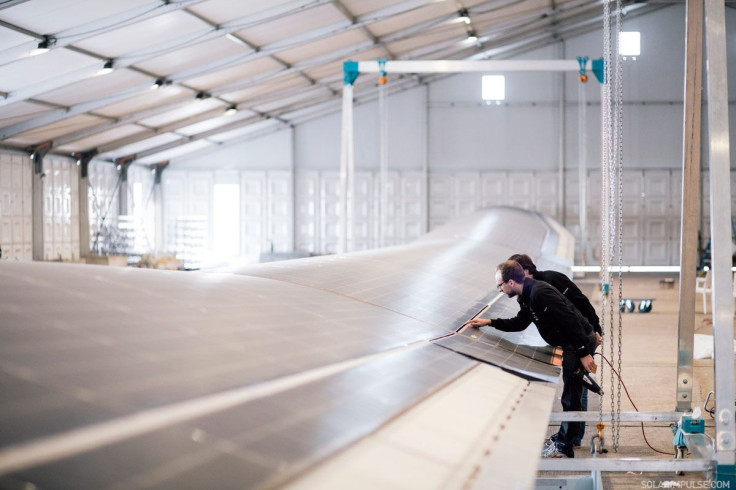Solar Impulse 2: Sun-Powered Aircraft Signals Major Progress In Global Solar Energy Sector

The price of going solar is dropping dramatically, with rooftop solar systems costing around 80 percent less today than in 2008. Panels are getting cheaper and easier to mass-produce, and the technology is becoming more efficient at turning sunbeams into clean electricity. In some parts of the United States, solar power is actually cheaper than conventional fossil fuel energy.
Solar energy is having a moment.
Plunging costs are allowing more Americans to put photovoltaic panels on their rooftops. Nearly 200,000 homes and businesses added on-site solar projects last year, bringing the country’s total count to more than 600,000, according to a recent industry report. Across all solar sectors, companies installed a record 6,200 megawatts of PV capacity in 2014 -- a 30 percent jump over the previous year. By 2020, developers worldwide are expected to spend more than $134 billion annually on solar energy systems, up by more than 50 percent compared to 2013, according to Navigant Consulting Inc.
Perhaps no project better captures the industry’s achievements than the Solar Impulse 2, the panel-powered aircraft currently circumnavigating the globe and set to land on U.S. soil this spring. Solar experts say the Impulse mission shows the public just how far PV technology has advanced.
With the solar plane, “We’re able to do something we weren’t able to even 10 years ago,” said Neil Abrams, a professor and solar energy researcher at the State University of New York’s College of Environmental Science and Forestry in Syracuse.
Two Swiss pilots, Bertrand Piccard and André Borschberg, are leading the airborne mission, which launched March 9 from Abu Dhabi in the United Arab Emirates. Borschberg flew the one-person aircraft for 13 hours to Muscat, Oman. Piccard then took it over the Arabian Sea to Ahmedabad, India. Borschberg is scheduled to take over controls again early Wednesday local time and fly to the Indian city of Varanasi. The plane next travels to Myanmar and China before landing in Hawaii, Phoenix, an undetermined city in the U.S. Midwest and New York City. The 12-stop mission will end sometime this spring back in Abu Dhabi.
“Our challenge is to attempt the first round-the-world solar flight … to demonstrate how pioneering spirit, innovation and clean technologies can change the world,” the pilots said on the Solar Impulse website, which tracks the flights in real time.
The Solar Impulse 2 is outfitted with 17,000 solar cells -- the devices in panels that convert sunlight to electricity. The cells provide power for four electric motors and recharge an array of custom-designed lithium batteries. (A prototype of the plane, Solar Impulse 1, flew from San Francisco to New York in May 2013.)

Gregory Wilson, who directs the U.S. Department of Energy’s National Center for Photovoltaics in Golden, Colorado, said the aircraft showcases the best of existing solar technology. Solar cells on the plane are about twice as efficient at turning sun rays into electricity as a typical household model. The cells themselves are flexible and wrap around the plane’s wings, unlike the stiff, flat rectangles used in most rooftop systems. The aircraft’s battery storage system makes it self-sufficient, whereas most buildings with solar panels still rely on the utility grid to keep the lights on around the clock.
“It shows that those technologies are just right out there beyond our fingertips, but could start becoming real [for consumers] within a couple of years,” Wilson said.
Abrams said he is most excited by the aircraft’s ability to fly nonstop by combining solar cells and batteries. “That’s the biggest hangup in the wide adoption of solar power: When the sun goes down, how does [the system] work?” he said.
On the ground, solar companies are increasingly attempting to address the challenge of round-the-clock solar power. On Monday, SolarCity Corp., the rooftop installer chaired by Elon Musk, said it was launching a “microgrid” service to help its customers keep the lights on at night and during grid blackouts. The microgrids will draw energy from SolarCity’s panels and store the power in batteries made by Musk's Tesla Motors Inc.
“Storage deployed at the wider scale is still a challenge, but we’re getting there,” Abrams said.
Ken Johnson, a spokesman for the Solar Energy Industries Association, a trade group, acknowledged that the Solar Impulse flight is “primarily inspirational.” But he added, “We’re confident that the innovative, breakthrough processes which made this flight possible will have real-world applications in the not-too-distant future. … Solar is the fastest-growing source of energy in the United States -- and our best days are ahead of us.”
The massive adoption of solar power and other renewable energy resources is critical for fighting climate change. Scientists say the world must reduce emissions of greenhouse gases to 80 percent below 1990 levels within the next four decades in order to keep the planet from warming by 2 degrees Celsius (3.6 degrees Fahrenheit). To achieve those reductions, most of the world’s remaining oil, coal and natural gas will have to stay in the ground, global climate experts agree.
Yet only about 21 percent of the world’s electricity generation comes from renewable energy and hydropower at this point, according to U.S. energy statistics. Solar PV systems account for only a sliver of that amount.
If countries boosted solar output to 20 percent of total energy production by 2025, global emissions would drop by around 19 percent, Wilson said. “Solar is almost certainly going to be the most significant technology in the next 20 years for taking carbon out of our electricity system,” he said.
The Solar Impulse, he added, “at least is going to get the public asking the right questions about energy supplies.”
© Copyright IBTimes 2024. All rights reserved.





















